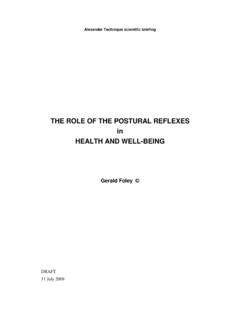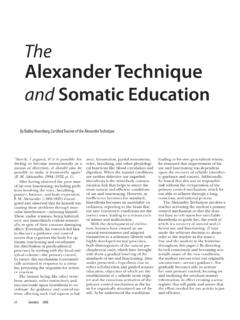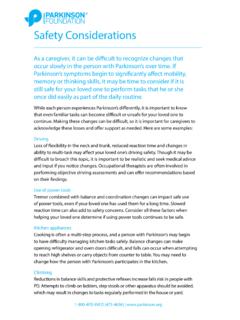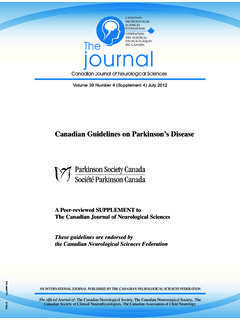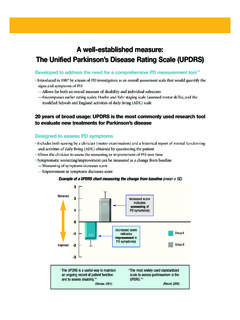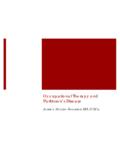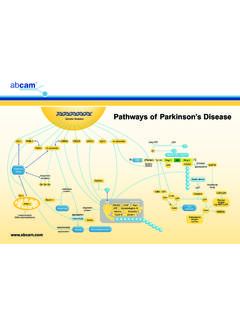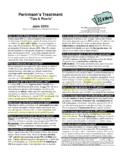Transcription of The Alexander Technique and Parkinson’s Disease: …
1 AmSAT News / Summer 2010 / Issue No. 83 Journal: Alexander Technique in Action The Alexander Technique and parkinson s Disease: A Case Study in Generating Hope for a Degenerative Condition by Ruth Rootberg In the summer of 2008 a student of mine who is a physician urged me to see her patient, "Sabrina" (fictitious name), a senior citizen with parkinson s disease. The physician was concerned because Sabrina s breathing was becoming compromised as her chest increasingly collapsed downward. I agreed to see Sabrina to discuss what the Alexander Technique might offer her and under what circumstances we could arrange lessons.
2 I was both curious and terrified about teaching her to re-coordinate neuro-muscular patterning while her nervous system was progressively deteriorating. How could I help her, and for how long? Before meeting Sabrina, I did some research. parkinson s Disease parkinson s Disease is a progressive, neurodegenerative movement disorder with symptoms that may include trembling in the hands, arms, legs, jaw, and face (tremor), rigidity and stiffness, slowness of movement, difficulty in initiating movement, and postural instability (impaired balance).1 parkinson s patients typically develop a stooped, head-down, shoulders-drooped stance with a tendency to lean unnaturally forward or backward, and they tend to walk with a distinctive unsteady shuffling parkinson 's is generally considered a disease of late middle age with the average age of onset at around 60 years of Idiopathic parkinson 's disease is the most common form; it is called idiopathic because the cause for the condition is There is no known cure for parkinson s disease.
3 Medical treatment involves powerful medications that act to reduce the symptoms and hopefully slow the pace at which the disease progresses. These powerful medications may produce unwanted side-effects, however, so care is taken in regulating and changing dosages as conditions warrant. Some parkinson s patients undergo deep brain stimulation. 5 In patients with parkinson 's disease, nerve cells in this region degenerate, causing tremors, stiffness, slowed movement, and loss of coordination. During this surgical procedure, electrodes are implanted that deliver electrical impulses to the region in the center of the brain that controls and coordinates movement.
4 Physical therapy treatment stresses increasing patients comfort level and ability to manage daily life activities independently. This is where the Alexander Technique comes in. There has been one randomized, controlled study of the Alexander Technique for patients with idiopathic parkinson s disease (2002).6 This study by Chloe Stallibrass, , and colleagues included one group that received 24 private lessons and a control group. The results showed that the group receiving the lessons improved at a statistically notable level compared to the control group, as measured after the lessons and six months later.
5 Participants described improvements in walking, speech, improved posture or balance, greater energy, reduced tremor, and reduced rigidity or muscle tension. Some reported reduced stress or greater composure. Fewer changed their medications during the intervention or the six months following. Sabrina Armed with the results of my research, I met with Sabrina. Sabrina s chief complaint was neck pain. That was not surprising: her back was rounded like a crescent roll, and her chest was collapsed, just as her doctor had described, leaving no room for the ribs to move. Her neck jutted forward, and almost every sentence was broken as she struggled for air.
6 She also had a tremor in her jaw and face. When we began lessons, Sabrina could still drive and walked without a cane or walker. A former Montessori teacher, she responded quickly to my words and touch; I knew she could learn the Alexander Technique and that it could relieve some discomfort, but I had no idea whether her quality of life might change. After reading Chloe Stallibrass research, Sabrina s son encouraged her to take regular lessons, but she wasn t sure she could afford them. We made a bargain: she would come to my weekly private lessons with Missy Vineyard and serve as my practice student.
7 I would pay for the lessons (she would not have to pay), and both of us would receive the benefit of Missy s expertise. I had been bringing a practice student to lessons with Missy for a couple of years. Usually I simply gave the student a lesson, while Missy put her hands on me, steering me away from my habits of misuse. Now I wanted to draw on Missy s long-term experience and considerable pedagogical, observational, and intuitive skills in dealing with someone whose problems were more severe than those of most students I had encountered. During the lessons, I remained in the teacher role most of the time.
8 Missy had a dual role, sometimes putting hands on me, sometimes on Sabrina. In our first meeting as a three-some, Sabrina shared her worries that she couldn t stop her tremors. Missy said: Your tremor simply is. It happens. It s not your job to control it. That simple statement inspired me. It reinforced the role I wanted to play as teacher: It was not my responsibility to cure Sabrina s tremor; my business was to teach her to inhibit and direct. I would use my hands and also teach her these cognitive skills, so she could apply them by herself. During the first several lessons, I worked with Sabrina while she lay on the table.
9 She told us about the neck pillow that sent her head back and down all night long as she slept. No wonder she was aching! Missy and I convinced her to discard the neck pillow and put a regular pillow under her head instead. We also showed her how a few well-placed pillows under her shoulders and knees could support her more comfortably. She returned the next week, amazed at how well she had adapted to the new pillow arrangement in such a short time. Then she showed us how she tugged her head back first thing after she woke up in the morning, believing this was a good stretch. We taught her to just lie still for a bit, quieting her thoughts, before she got out of bed.
10 After a half dozen sessions, she started reading Missy s book, How You Stand, How You Move, How You Her attention during the lessons deepened. Sabrina attends Quaker meetings, and she related quieting her mental chatter 8 to sitting "Your tremor simply is. It happens. It s not your job to control it." 1 AmSAT News / Summer 2010 / Issue No. 83 Journal: Alexander Technique in Action at meetings. As I witnessed Sabrina s increasing ability to quiet her mind, I shifted focus to chair turns and taught her to think up, while Missy helped me encourage direction with my hands. During the first chair lesson, something amazing happened: Sabrina s torso lengthened and her tremor stopped.
